Last updated on May 15th, 2025 at 04:37 pm
Planning a trip to the Gili Islands? Located just off the northwest coast of Lombok, Indonesia, the Gili Islands are a world-renowned tropical paradise featuring white-sand beaches, turquoise waters, and the most relaxed vibe in the world!
Whether you’re looking for vibrant nightlife, peaceful retreats, or epic snorkeling and diving spots, Gili Trawangan, Gili Air, and Gili Meno each offer something unique.
In this ultimate guide to visiting the Gili Islands travel guide, you’ll find everything you need to plan your perfect getaway – from how to get to the Gili Islands and where to stay, to the best things to do on each island.
Whether you’re a backpacker, honeymooner, or solo traveler, this guide to the Gili Islands will help you make the most of your time in one of Indonesia’s most stunning island destinations.
For an even more unforgettable Indonesian adventure, consider combining the Gili Islands with both Bali and the lesser-visited island of Lombok. Check out our Bali–Lombok–Gili Islands itinerary for the ultimate travel route through some of Indonesia’s most beautiful and diverse destinations.
Best Gili Island to Visit: A Comparison of Gili T, Gili Air & Gili Meno
You have decided on a Gili Islands trip, well done on a fantastic decision!
Now for the hard part, determining which Gili Island is best for you – check out our more detailed article addressing this question!
Let’s kick off this Ultimate Guide to Visiting the Gili Islands with a brief summary of what each Gili Island offers to help with your decision.
Gili Trawangan: The Largest and Most Lively Gili Island
Size and Popularity:
Gili Trawangan, often called “Gili T,” is the largest and most developed of the three Gili Islands. It’s the most popular Gili Island for backpackers and younger travelers, offering the widest range of accommodations, restaurants, beach bars, and nightlife. If you’re looking for a vibrant social scene and plenty of amenities, Gili Trawangan is your ideal island destination.
Things to Do on Gili Trawangan:
Gili Trawangan is a hotspot for adventure and fun. Similarly to the other Gili Islands, visitors can enjoy world-class snorkeling and scuba diving, paddleboarding, kayaking, and island biking. What sets Gili T apart is its famous party scene, with beach clubs and nightlife venues that keep the island lively well into the night.
Gili Trawangan is the most famous Gili Island for nightlife.
Gili Air: The Perfect Balance Between Relaxation and Activity
Vibe and Atmosphere:
Gili Air offers a relaxed yet social island experience – making it a favorite for many travelers – us included! In our opinion, Gili Air strikes the perfect balance between the energetic vibe of Gili Trawangan and the tranquility of Gili Meno. While it’s quieter and less crowded than Gili T, Gili Air still features a great selection of restaurants, beach bars, and activities.
Local Culture and Experience:
With a more authentic and laid-back atmosphere, Gili Air is ideal for those who want to unwind while still enjoying modern comforts. It’s also a great place to connect with local culture and enjoy yoga retreats or wellness experiences.
Gili Air is the most popular Gili Island for families.
Gili Meno: The Quietest and Most Romantic Gili Island
Tranquility and Nature:
Gili Meno is the smallest and least developed of the Gili Islands, making it the top choice for couples, honeymooners, and those seeking a quiet escape. Gili Meno offers a peaceful, intimate Gili island experience with fewer tourists, pristine beaches, and stunning sunsets.
Eco-Friendly and Romantic:
Known as the “Honeymoon Island,” Gili Meno is praised for its eco-conscious efforts and natural charm. The island features eco-resorts, turtle sanctuaries, and some of the best spots for snorkeling with underwater statues and vibrant marine life.
Gili Meno is the best Gili Island for couples.
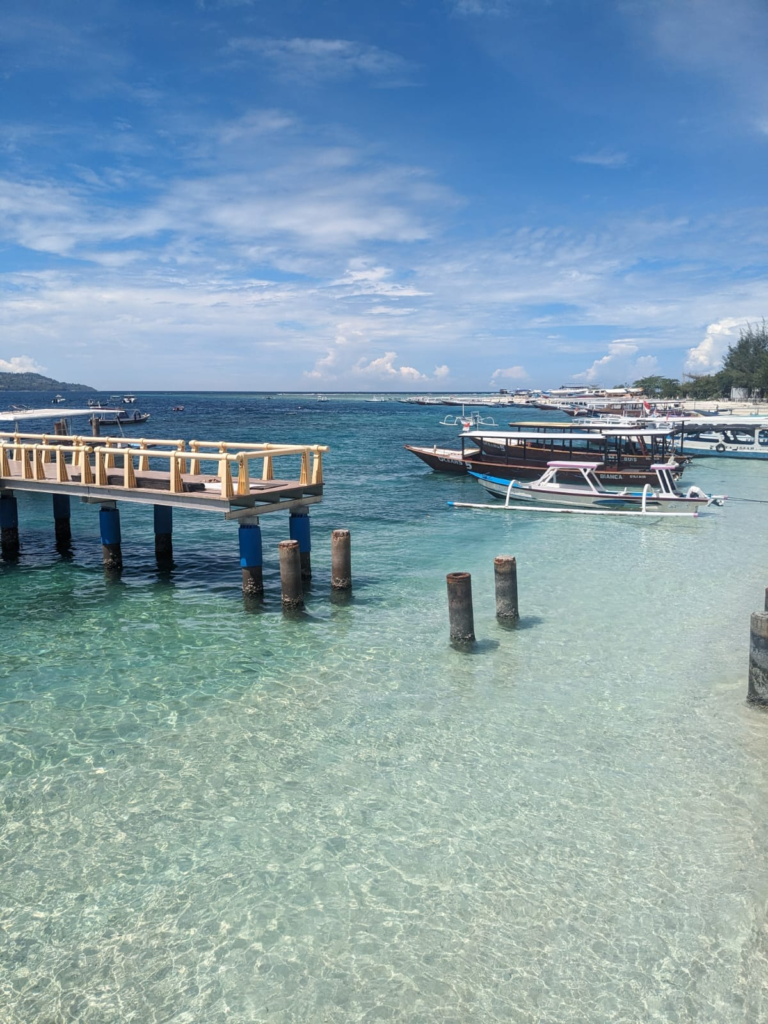
Ultimately, deciding which Gili Island to visit depends on your travel style and what kind of experience you’re after.
If you’re looking for lively beach parties, social vibes, and a wide selection of restaurants and bars, Gili Trawangan is the best Gili Island for nightlife and entertainment.
Do you prefer a mix of relaxation and activities? Gili Air offers the perfect balance – ideal for families, couples, solo travelers, and really, anyone who wants a laid-back atmosphere without missing out on the best Gili Island things to do.
For peace, privacy, and a truly romantic setting, Gili Meno is the best Gili Island for a secluded escape. Known for its quiet beaches and honeymoon vibes, it’s perfect for those seeking tranquility.
Honestly, we don’t think you can make a wrong decision when deciding which Gili Island is best. No matter which island you choose, you’ll be treated to stunning beaches, crystal-clear water, and the charm that makes the Gili Islands one of Indonesia’s top travel destinations.
To be best prepared for your trip, make sure to check out our complete guide to your Indonesia holiday.
Do I Need a Gili Island Visa?
Yes, travelers to the Gili Islands – which are part of Indonesia – will need an Indonesian tourist visa. For most nationalities, the easiest option is the Visa on Arrival (VoA), which is valid for 30 days and can be extended once.
The cost of the Visa on Arrival is 500,000 IDR (approximately €30 / $30 USD / $50 AUD), even though all these prices don’t match up!
You can obtain the visa upon arrival at the airport before passing through immigration. Simply present your passport (with at least 6 months’ validity), pay the fee, and receive your precious entry stamp.
Payment can be made in USD or EUR, and card payments are usually accepted – with a 3% surcharge for card transactions.
What are the Gili Islands Top Attractions?
Quick Tip: Most of the top activities on the Gili Islands center around the ocean and wellness – think snorkeling, diving, paddleboarding, and beachside yoga.
Let’s just say, if sun, sand, and sea aren’t your thing, you might want to reconsider a Gili Islands getaway! But don’t worry – we’ve got plenty of other adventurous Indonesian itineraries lined up below that might be more your style.
Best Things to do on the Gili Islands: Paradise Beaches
Gili Trawangan: Explore the famous Sunset Beach on the West Coast, known for its (surprise, surprise) sunset views!
Gili Air: The eastern side of the island is particularly popular for swimming and snorkeling.
Gili Meno: Turtle Point is famous for its turtle population (another surprise!) Gili Meno is the best Gili Island for encountering turtles, we spotted loads during our time on this lesser-visited Gili Island.
Best Things to do on the Gili Islands: Snorkeling and Diving
The Gili Islands are famous for their vibrant coral reefs and diverse marine life, making them a top destination for snorkeling and scuba diving in Indonesia. Must-visit spots include Shark Point (despite the intimidating name, it’s beginner-friendly!), Manta Point, and the iconic Underwater Statues near Gili Meno, a favorite for both snorkelers and Instagrammers alike.
Best Things to do on the Gili Islands: Turtle Sanctuaries
Gili Meno is renowned for its sea turtle conservation efforts, offering visitors a chance to support marine life while exploring the island. The Turtle Conservation and Education Center is dedicated to rescuing, rehabilitating, and releasing baby turtles back into the ocean, making it one of the most meaningful attractions in Gili Meno.
Best Things to do on the Gili Islands: Nightlife
Gili Trawangan is the ultimate destination for those seeking vibrant nightlife and a lively beach scene in the Gili Islands. With its range of beachfront bars, reggae clubs, and lively beach parties, Gili T is perfect for partygoers looking to dance the night away under the stars.
That being said, in each of the Gili Islands you will find a variety of live bands, vibrant bars, and great restaurants. While all the islands have something to offer, Gili Trawangan just has more nightlife and dining options.
We enjoyed many a great Reggae night out in Gili Air!
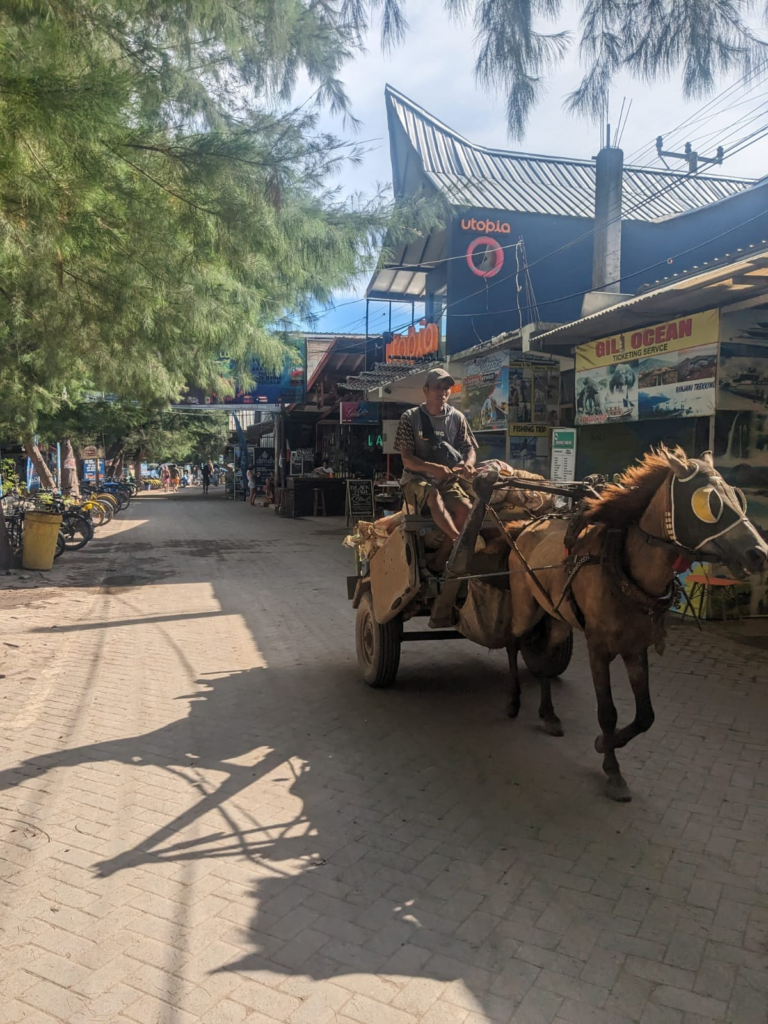
We were definitely missing the buzz of a good food market on the Gili Islands – they’re much more about sit-down restaurants. So stumbling upon the lively night market in Gili Trawangan felt like striking gold! It’s the perfect place to feast on local dishes, soak up the island vibes, and give our wallets a little break. Budget travelers, rejoice! Don’t miss the sizzling satay skewers, freshly grilled seafood, and plates of nasi goreng made right in front of you – cheap, cheerful, and seriously tasty.
Best Things to do on the Gili Islands: Gili Meno Salt Lake
Gili Meno is home to a serene saltwater lake at the heart of the island, offering a peaceful retreat for visitors. It’s the perfect spot for a relaxing walk or bike ride, surrounded by nature and away from the bustling crowds of the other Gili Islands.
Best Things to do on the Gili Islands: Yoga and Wellness
The Gili Islands are home to a variety of resorts and yoga centers that offer yoga classes, meditation sessions, and wellness activities for all experience levels.
Among them, Gili Air stands out as the most popular Gili island for yoga retreats and wellness getaways, making it the best Gili Island choice for those seeking relaxation and rejuvenation.
Best Things to do on the Gili Islands: Island Hopping
Take a boat tour around the Gili Islands and explore all three islands in a single day on this top-rated Gili Islands Tour. This is the perfect way to experience the unique charm and atmosphere of Gili Trawangan, Gili Air, and Gili Meno, each offering its distinct vibe and attractions.
If island hopping is up your street then make sure to check out our Thailand Island Hopping itinerary.
*Remember to respect the local environment and marine life when participating in water activities on the Gili Islands.
What is the Best Time to Visit the Gili Islands?
The best time to visit the Gili Islands is during the dry season, which typically occurs from May to September. During this period, the weather is generally sunny, and rainfall is minimal – perfect for a trip to paradise!
Here’s a breakdown of the seasons for visiting the Gili Islands:
Dry Season (May to September):
Weather: This is the peak tourist season for the Gili Islands, with dry and sunny weather with lower humidity. The sea conditions are usually calm and suitable for water activities like snorkeling and diving.
Temperature: Daytime temperatures range from 26°C to 32°C (79°F to 90°F).

Best Travel Insurance– Even with the luck of the Irish, things can still go wrong. World Nomads Travel Insurance is our top choice for travel coverage. With the best transparent fine print in the industry, it’s no wonder they’re ranked number one. Don’t let your Gili adventures turn into mishaps and get a free quote today!
Wet Season (October to April):
Weather: The wet season brings higher humidity and an increased chance of rainfall, with the peak of the rainy season occurring from December to March. November and April are transitional months.
Temperature: The temperatures remain warm, but the increased humidity can make the weather feel a lot sweatier and hotter!
We visited the Gili Islands in January and only had two rainy days in our 30-day Indonesia itinerary – it mostly rained during the night.
Additionally, be aware that peak holiday periods may result in higher accommodation prices and more crowded attractions in the Gili Islands.
What is The Currency in the Gili Islands?
The Rupiah is the currency of Indonesia (IDR). At the time of writing 100000 IDR is around the 5.80 Euro mark.

How Much Should You Budget for Your Gili Islands Trip?
A Gili Island budget can vary significantly based on lots of factors, including travel style, accommodation preferences, duration of stay, activities planned, and personal spending habits.
However, here’s a rough breakdown to help you plan your budget for your Gili Island holiday:
Accommodation: Gili Trawangan offers the widest range of accommodation options, from budget hostels to luxury resorts, making it ideal for all types of travelers.
Gili Air provides a solid variety of places to stay, offering a mix of comfort and a laid-back atmosphere.

Gili Meno, while more peaceful and secluded, tends to have fewer accommodations, and as a result, prices can be higher compared to the other islands, with a stronger focus on tranquility and nature retreats.
We spent on average 12 Euros per night for a private room with A/C, WiFi, and balcony/terrace. All offering a shared pool and free breakfast. What else do you need?! *We HIGHLY recommend getting accommodation with a pool, especially at this time of year (January). Trust us you won’t regret it!
Food: The Gili Islands offer plenty of affordable dining options, with street food and local restaurants serving delicious meals starting at just 1-5 Euros per meal. Popular dishes like Nasi Goreng and Mie Goreng range from 15k to 25k IDR, meaning you can enjoy a satisfying meal without breaking the bank. Of course, if you choose to dine at upscale restaurants, prices will be higher, but you’ll still find plenty of budget-friendly options to suit your needs.
The following video offers a sneak peek at some of the delicious dishes we’ve enjoyed in Indonesia. Be sure to explore our social media for more Indonesian food videos and other tasty highlights from our travels!
Activities: Being on an island paradise, the Gili Islands offer a wide variety of water activities to choose from. While some experiences, like scuba diving and snorkeling day trips, can be more expensive, other options such as SUP (stand-up paddleboarding) and kayak rentals are more affordable and still provide an exciting way to explore the crystal-clear waters.
Miscellaneous: Always budget for additional expenses like shopping, nightlife, SIM cards, and unforeseen costs.

must-try Indonesian dish at 15k IDR (88cent)
Gili Islands budget as a rough estimate:
Budget Travelers: A budget traveler visiting the Gili Islands can expect to spend around 20-50 Euros per day. By staying in hostels, enjoying street food, and opting for walking instead of bike rentals or horse-drawn carts, you can keep costs low. Additionally, there are plenty of free or low-cost activities to enjoy, allowing you to experience the beauty of the Gili islands without overspending.
We’ve been traveling full-time for over 3 years at the time of writing, read more about how we eat cheaply around the world.
Mid-Range Travelers: For mid-range travelers to the Gili Islands, a daily budget of 50-100 Euros is ideal. This allows for stays in mid-range hotels, dining at a mix of local restaurants and nicer eateries, enjoying guided tours, and adding a bit more comfort to your island experience.
Luxury Travelers: For luxury travelers, the daily budget on the Gili Islands can easily exceed 100 Euros, offering the chance to indulge in upscale accommodations, fine dining, exclusive experiences, and private transportation for a truly premium experience.
Consider making a Gili Islands trip part of the ultimate 2-week Indonesia itinerary for a perfect mix of adventure and relaxation.
Gili Islands Budget: Alcohol
Alcohol is widely available in the Gili Islands.

Alcohol on the Gili Islands includes beer, spirits, cocktails, and local beverages. You can find alcohol in convenience stores, supermarkets, bars, and restaurants.
In certain regions, there is a predominantly Muslim population, leading to potential limitations on alcohol. Therefore, it’s crucial to do your research beforehand, and always respect the local customs of the area you are lucky enough to be visiting.
Local Beers: Indonesia has several popular local beer brands, such as Bintang and Anker.
Local spirits: Arak is a traditional Indonesian distilled spirit, often made from rice or palm sap and it has a high alcohol content.
*A small beer costs about 2 Euro (35k) in a bar/restaurant and a cocktail upwards of 2.60 Euro (65k-85k).
Buying alcohol in convenience stores is a lot more expensive in Indonesia than in other South East Asia countries such as Thailand.
For example, a 700ml of the local spirit Arak in a shop would set you back 12-17 Euro (220k-300k), which is pretty much the same cost as at home in Ireland. If you find cheaper please let us know!
Transport – How to Get Around the Gili Islands?
All three Gili Islands are easily accessible by boat from the mainland of Lombok, and there are also fast boat services connecting the Gili Islands to Bali.
The Gili Islands are car-free, and transportation on the islands primarily relies on alternative means such as bicycles, horse-drawn carriages (cidomos), and don’t forget you can just walk everywhere on these islands – we are Happy Irish WANDERERS after all!
Here’s an overview of the main modes of transportation on the Gili Islands:
Bicycles: Bicycles are a popular and eco-friendly mode of transportation on all three Gili Islands. The landscapes on the islands are mainly flat so it is super easy.

Cidomos (Horse-drawn Carriages):
Cidomos are traditional horse-drawn carriages that serve as a popular mode of transportation on the Gili Islands. While they offer a charming way to explore the islands, it’s essential to be mindful of the well-being of the horses.
Walking:
Due to the compact nature of the Gili Islands, walking is one of the best ways to explore. With most accommodations, restaurants, and popular attractions within walking distance, it’s an easy and enjoyable way to experience the Gili Islands at a relaxed pace.
Electric Scooters:
In recent years, some areas on Gili Trawangan have introduced electric scooters as an alternative for those who may not prefer cycling or walking.
Boats and Water Taxis:
As the Gili Islands are situated close to each other and the mainland of Lombok, boat transport is essential. Regular boat services operate between the islands and the mainland, and between the Gili Islands. Tickets can be easily booked online via 12go.
If you are craving some off-the-beaten-track adventure after all your relaxing in the Gili Islands, check out the best things to do in Lombok – think hidden waterfalls, lush jungles, and volcano hikes!
From Gili Air to Gili Trawangan there is a public, cheaper boat services (45K IDR/2.60 Euro) that runs between the island twice daily and a fast boat at a higher cost of 85K IDR/5 Euro.
*Prices will vary depending on which island you are leaving from/going to and usually there will be two local services running – one in the early morning and one in the late afternoon.
Can you use ATMs in the Gili Islands?
Each of the Gili islands has ATMs available but there are a few things to consider:
ATMs on each Gili Island (at the time of writing):
Gili Trawangan, being the largest and most developed of the Gili Islands, has the most ATMs, often located near the harbor or in central areas with only one on the west coast.
Gili Air offers four ATMs, while Gili Meno has just one ATM available for visitors.
Cash is King:
It’s probably smart to carry sufficient cash with you when traveling to the Gili Islands, just in case! While ATMs are available, they can occasionally run out of cash or experience technical issues.
Bank Branches on the Mainland:
If you are concerned about the availability of ATMs on the Gili Islands, you may want to withdraw cash on the mainland (Lombok or Bali) before taking the boat to the Gili Islands.
Check with Accommodations:
Before your trip, you can check with your accommodation provider for the latest information on ATM availability. Locals and staff at hotels or guesthouses can often provide helpful insights.
Each of our accommodations on the Gili Islands accepted card payments, as do many of the bars and restaurants, but always best to be prepared with cash.
A good idea is to order a travel card from your bank or order a Revolut travel money card so as to avoid any additional fees/charges.
The maximum amount you can withdraw is 3,000,000 IDR which is approximately 175 Euro. Some local Indonesian banks may offer lower withdrawal fees for foreigners such as Bank Negara Indonesia (BNI), Bank Rakyat Indonesia (BRI), and Bank Mandiri.
What Socket Type to use During my Gili Islands Trip?
In the Gili islands, the most commonly used electrical socket type is the Type C socket. This socket is also known as the Europlug and has two round prongs.
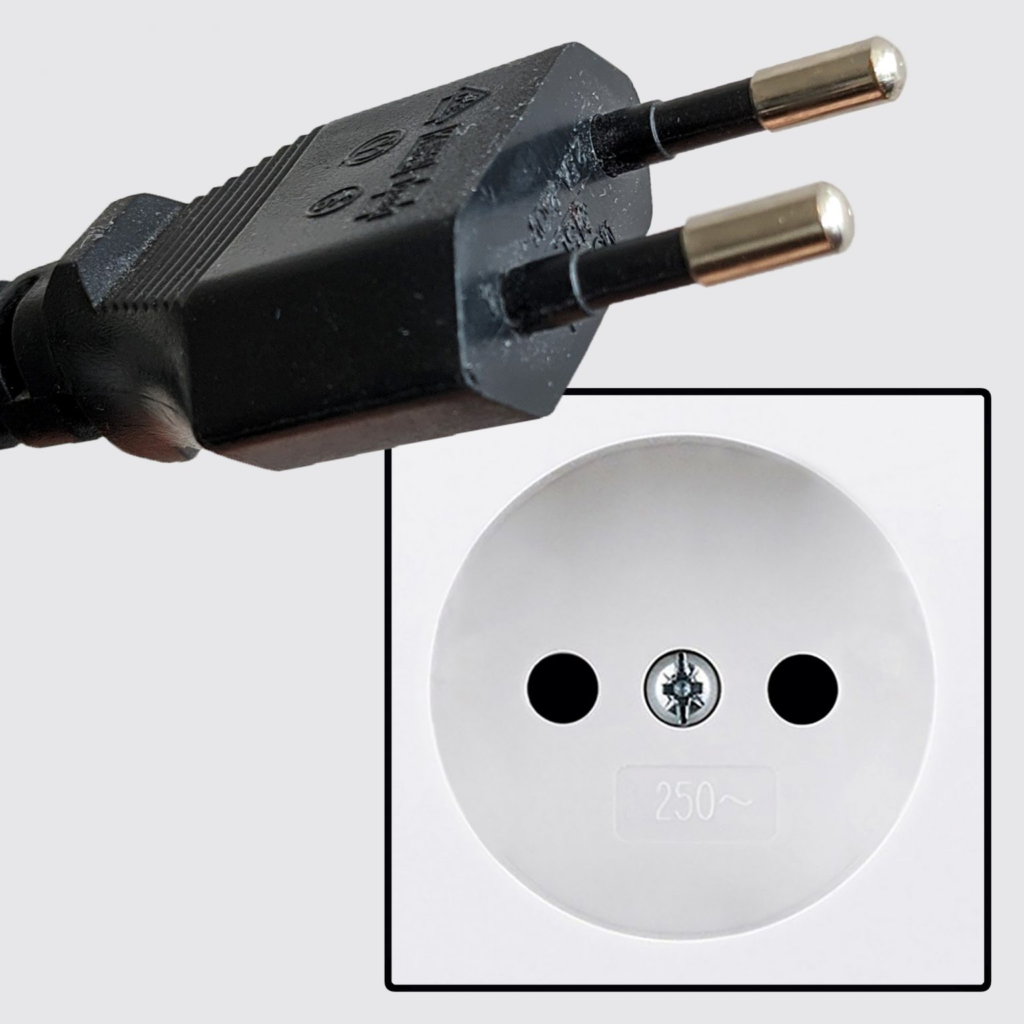
Consider purchasing a Multi Travel Adapter so you are prepared for any plug type?!
Is it Safe to Visit the Gili Islands?
Are the Gili Islands safe to visit?
It is in Indonesia, particularly on the Gili islands, that we have encountered some of the coolest, most welcoming people on our travels in Southeast Asia.
In short, the answer is yes – the Gili Islands are safe to visit, we never experienced at safety concerns while visiting, only genuine welcome.
However, this is not do say you should not take precaution and use your gut instinct regarding your own safety as you would anywhere in the world.
Below are some areas of caution to consider when visiting the Gili Islands:
Personal Safety: Indonesia is relatively safe for tourists. Violent crimes against tourists are rare, but petty theft and scams can occur, especially in crowded tourist areas.
Health and Hygiene: Be mindful of food and water hygiene to avoid traveler’s diarrhea or food-related illnesses. We would recommend drinking bottled water when visiting the Gili Islands.
Cultural Sensitivities: Respect local customs, traditions, and cultural practices. Dress modestly when visiting local villages – there will be signs requesting tourists not to walk around in bikini tops in these areas. Always have a shawl of some sort in your bag to throw on if needs be – simple.
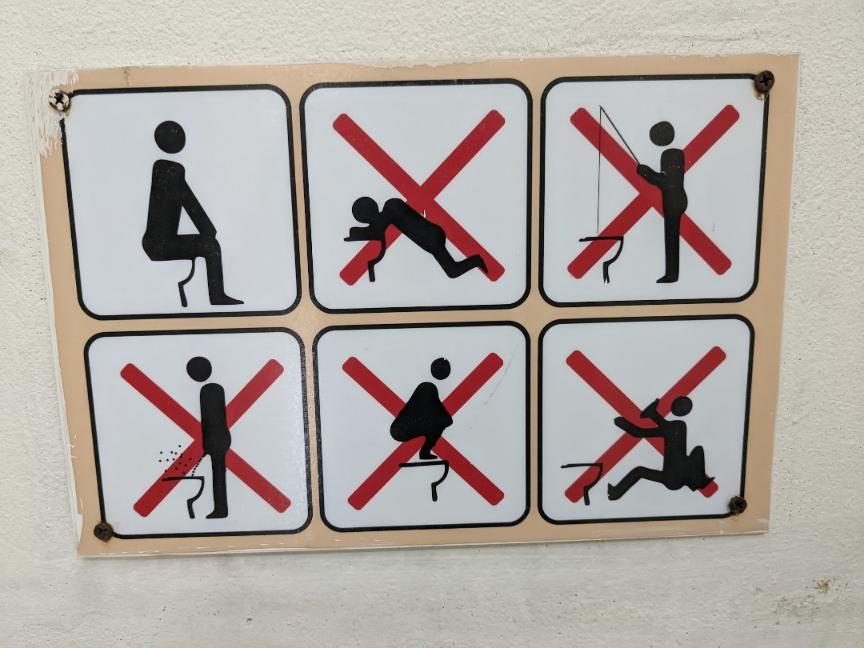
Scams: Be cautious of scams, particularly in tourist areas. Common scams include ATM card skimming, giving back incorrect change in shops/restaurants and even currency exchange businesses.
Natural Disasters: Indonesia, situated in the Ring of Fire, experiences seismic and volcanic activity. While the country faces natural disaster risks, these are not constant. Travelers should stay informed, follow government alerts, and be prepared. Many popular tourist destinations have safety measures in place, and millions of tourists visit Indonesia and the Gili islands safely each year.
What Language is Spoken in the Gili Islands?
While Indonesian – Bahasa Indonesia – is the primary language, English is widely spoken in the Gili Islands, particularly in tourist areas, hotels, dive shops, and restaurants – so most travelers will have no problem communicating.
That said, having a basic understanding of a few Indonesian phrases can go a long way. It not only helps with simple communication but also shows respect and appreciation when interacting with locals.
To help you out, here are some useful Indonesian phrases to get you started:
- Hello / Hi: Halo (pronounced hah-loh)
- Thank you: Terima kasih (pronounced te-ree-mah ka-seeh)
- Yes: Ya (pronounced yah)
- No: Tidak (pronounced tee-dah)
- Please: Tolong (pronounced toh-long)
- Excuse me / I’m sorry: Maaf (pronounced mah-ahf)
- Good morning: Selamat pagi (pronounced suh-lah-mat pah-gee)
- Delicious!: Enak! (pronounced eh-nahk!)
- Good evening: Selamat malam (pronounced suh-lah-mat mah-lahm)
- How much is this?: Berapa harganya? (pronounced buh-rah-pah har-gah-nya)
What SIM Card to Get for my Gili Islands Trip?
Obtaining a local SIM card on the Gili Islands, particularly Gili Trawangan, is possible.
You can find SIM cards at various shops and stalls on Gili Trawangan. These shops may include convenience stores, local vendors, or authorized dealers of the mobile network providers.
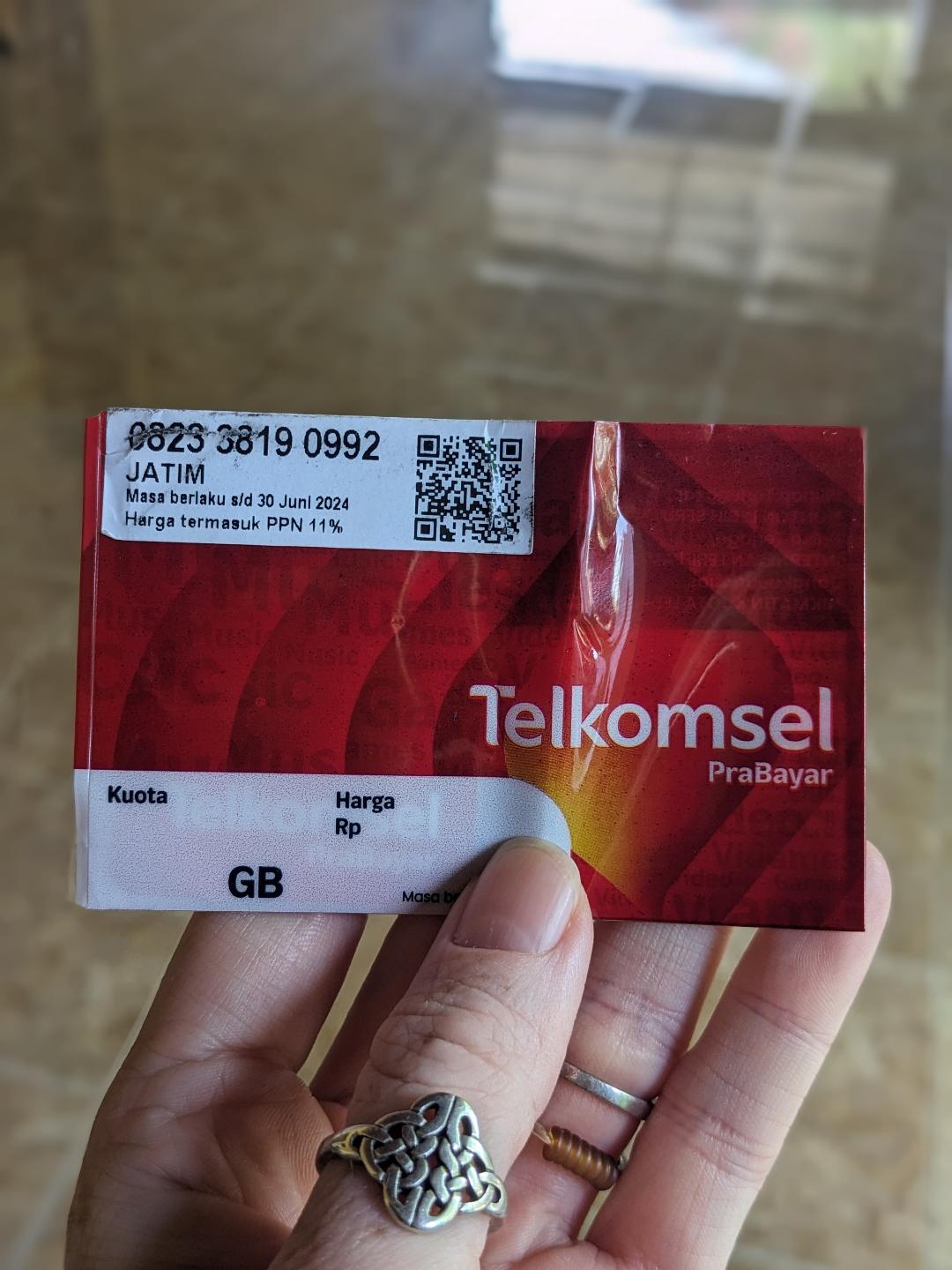
When we arrived at the airport in Surabaya we were being charged nearly 18 Euro (300k) for a sim card with 8GB. We chose not to go with this deal and instead asked at our hotel where the best place to obtain a sim card.
We went to a local GraPARI-Telkomsel store and we purchased a Telkomsel sim (we just bought one sim – with 50GB with can hotspot for the other person and we’ll always have good WiFi at our accommodations).
By choosing this option, we ended up getting 50GB for 5.80 Euro (100k) plus a sim for 60cent (10k). This is just an example that if you are not happy with the initial price then hold out and ask around.
To purchase a SIM card, you will generally need to provide identification so don’t forget your passport!
What Packing Essentials Do I Need For The Gili Islands?
The following list is our essential list when visiting the Gili Islands and basically for any island living!
- Dry bag – for those snorkeling/Gili Island tour days.
- Phone Lanyard – confidently take photos from the tour boat without fear of your phone falling into the water.
- Waterproof phone case – same reason as above!
- Multi Travel Adapter – so you are prepared for any plug type during your travels!
- Battery Pack – to charge your phone from all the photos taken.
- Light Raincoat – if visiting the Gili Islands during wet season
- Flip Flops (or thongs!) – wear shoes that you don’t mind getting wet.
- Light clothing – because you will be sweating!
- Download apps such a Google Translate, Google Maps and Booking.com.
- Utilize budget apps such as TravelSpend to keep track of your spending.
- A sense of adventure and a BIG SMILE.

You can find the full list of our travel tips here – we have lots more suggestions!
Are the Gili Islands Worth Visiting?
Are the Gili Islands worth visiting? In short, 100% yes the Gili Islands are worth visiting, and why? Because they are Indonesian Paradise!
The Gili Islands are somewhere we will most definitely be returning to. We loved them so much that we were already planning our return trip while we were still there!
In each of the Gili Islands, you will be witnessing some of the most breathtaking turquoise waters and most beautiful beaches in the world.
Whether you choose to lounge on one of the countless bean bags/hammocks, enjoy the scenery, read a book, partake in yoga and meditation classes, or indulge in the various water activities – or all of the above – the Gili islands have something for everyone. And are certain to make for one epic Indonesia holiday.

The people of the Gili Islands are some of the coolest we’ve met. Honestly, Indonesians in general are a pretty awesome bunch – you’ll feel like family in no time.
*The low costs and unbelievable food are just added bonuses to visiting the Gili Islands!
But why stop there, continue the short and cheap boat trip over to the island of Lombok, you won’t regret it! Alternatively, if you have time, consider a trip to our favorite adventure Island in Indonesia – East Java.
Enjoy Your Gili Islands Holiday!
We finally got to visit the Gili islands 8 years after initially planned, and let’s just sat it was worth the wait!
Fully aware the Gili Islands is a top tourist destination in Indonesia, we were unsure how we would feel being in such a popular and possibly crowded place – even in low season.
However, we now understand why the Gili islands are a top choice amongst all types of travellers. The moment you step foot off the boat, particularly for us in Gili Air, you feel an air (pun intended!) of relaxation and chill vibes.
The Gili Island vibe is infectious and yes we couldn’t help but fall head-first into holiday mode here, the budget didn’t seem to matter for those few days!
Even though we come from the beautiful island of Ireland, at this point in our travels we’ve probably written more about Indonesia than anywhere else. It’s a country that completely captured our hearts. If you’re planning a trip, be sure to dive into our Indonesia travel guides – they’re packed with our favorite spots, hidden gems, and itineraries we’ve loved.
What are your thoughts on this “Ultimate Guide to Visiting the Gili Islands”? Has this guide to the Gili Islands helped with planning your trip, or has one of our other more adventurous Indonesia itineraries grabbed your attention?
We love talking about island living so we would love to hear your thoughts about the Gili islands.
If you have any more questions just leave a message below or message us on our socials.
Slán go fóil


This post contains affiliate links. If you click on the links to make a purchase, we will earn a small commission. This is at NO EXTRA COST to you. This is a free way to support us and allow us to continue to create inspiring adventure travel guides.
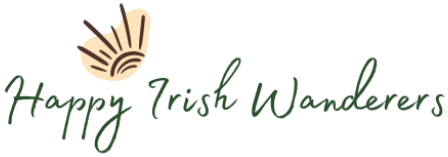

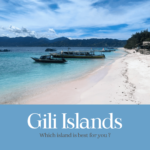


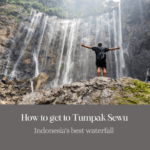
Is it really possible to sustain a lifestyle of full-time travel without burning out or running out of money? How do people make it work long-term and what sacrifices do they have to make to live this dream?”,
“refusal